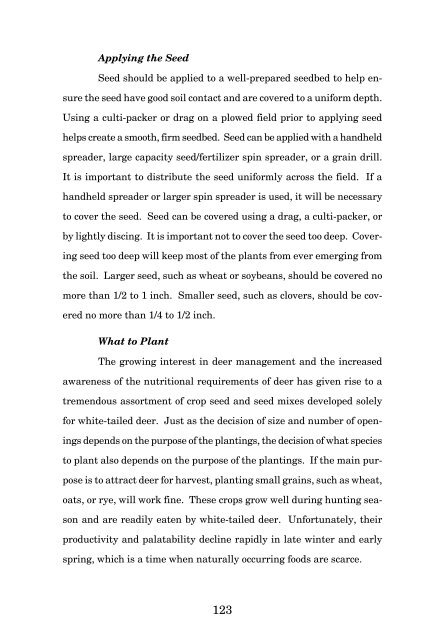Biology And Management Of White-tailed Deer In Alabama
Biology And Management Of White-tailed Deer In Alabama
Biology And Management Of White-tailed Deer In Alabama
Create successful ePaper yourself
Turn your PDF publications into a flip-book with our unique Google optimized e-Paper software.
Applying the Seed<br />
Seed should be applied to a well-prepared seedbed to help ensure<br />
the seed have good soil contact and are covered to a uniform depth.<br />
Using a culti-packer or drag on a plowed field prior to applying seed<br />
helps create a smooth, firm seedbed. Seed can be applied with a handheld<br />
spreader, large capacity seed/fertilizer spin spreader, or a grain drill.<br />
It is important to distribute the seed uniformly across the field. If a<br />
handheld spreader or larger spin spreader is used, it will be necessary<br />
to cover the seed. Seed can be covered using a drag, a culti-packer, or<br />
by lightly discing. It is important not to cover the seed too deep. Covering<br />
seed too deep will keep most of the plants from ever emerging from<br />
the soil. Larger seed, such as wheat or soybeans, should be covered no<br />
more than 1/2 to 1 inch. Smaller seed, such as clovers, should be covered<br />
no more than 1/4 to 1/2 inch.<br />
What to Plant<br />
The growing interest in deer management and the increased<br />
awareness of the nutritional requirements of deer has given rise to a<br />
tremendous assortment of crop seed and seed mixes developed solely<br />
for white-<strong>tailed</strong> deer. Just as the decision of size and number of openings<br />
depends on the purpose of the plantings, the decision of what species<br />
to plant also depends on the purpose of the plantings. If the main purpose<br />
is to attract deer for harvest, planting small grains, such as wheat,<br />
oats, or rye, will work fine. These crops grow well during hunting season<br />
and are readily eaten by white-<strong>tailed</strong> deer. Unfortunately, their<br />
productivity and palatability decline rapidly in late winter and early<br />
spring, which is a time when naturally occurring foods are scarce.<br />
123
















